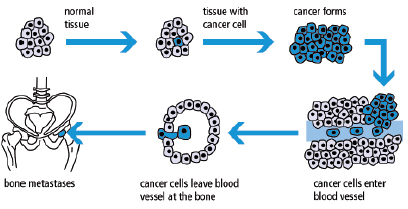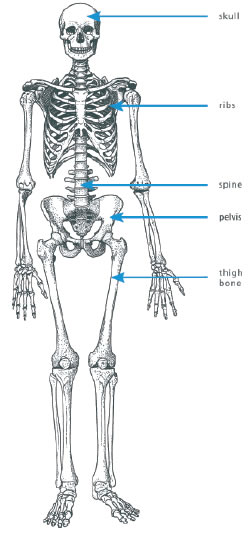Advanced Prostate Cancer with Bone Metastases!
Bone is the most common site of where the cancer cells from prostate spread. Once they spread into the bones, more complications can be generated by the disease. Therefore, it’s important for doctors to plan the appropriate treatment to prevent the metastasis of prostate cancer. At early stages of the disease (such as stage I and stage II), the cancerous cells don’t spread yet and these also are the most treatable stages of the disease.
Prostate cancer with bone metastases can be categorized into stage IV (the most advanced stage of the disease) which typically has the worst prognosis. Before the cancerous cells spread into the bone, typically they will affect the nearby sites first – such as pelvic cavity, rectum, bladder, and nearby muscles. For more detailed information about the stages of prostate cancer and the most common distinct sites for the metastasis of the disease, visit this section!
Bone metastases is also familiar called secondary bone cancer which means cancer that develops and occurs in the bone due to the cancer metastasis from other parts of the body.
In this section, we will discuss about the cancer of bone that comes from the cancerous cells of prostate. In other words, metastases don’t point to a new form of cancerous tumors, but it actually points to a new growth of the primary cancerous tumor.
And you may ever hear about the primary bone cancer – then what actually is it? It is the opposite of secondary type which means cancer of bone that develops from the original cells of the bone. So when doctors talking about bone cancer, it is usually referred to the primary type.
How about the treatments for both types? The approach treatment of each type is usually different. In general, the treatment for secondary type is more focused to treat the original site of where the cancerous cells come from. For instance, if the secondary bone cancer is caused by the metastasis of prostate cancer – then doctors more focus to treat the cancer of prostate itself and prevent it to spread to other parts of the body.
Bone metastases from cancer of prostate usually occur if the cancerous cells leave their primary original site (prostate) and move into the bloodstream of patient. After affecting the bloodstream, there is a chance from them to lodge in the bone of patient where they begin to form a new growth of cancerous tumor.
At first, this may only affect a very small area of the bone (one site). But in line with the progress of the disease there is a chance for the bone metastases to affect larger area of the bone (many sites), particularly true if left untreated! This metastasis may take several years to develop – depending on the aggressiveness level of the prostate cancer.
Below are some helpful pictures (source /credit to the Prostate Cancer Foundation of Australia):

They are pretty common in patients with advanced prostate cancer (at stage IV or when the cancerous cells have spread beyond the prostate). Other types of cancer that often spread into the bone are cancers of lung, breast, and kidneys.
So women with primary breast cancer and people with primary cancers of lung or kidneys – they are also more likely to have secondary bone cancer when they have primary cancer at advanced stage (the cancer cells have spread beyond the primary site).
Once cancer cells of prostate spread and affect the bone, the disease may still respond the treatment and also may be able to be controlled – but generally it is no longer to be cured completely. Therefore, the treatments are more focused on how to eliminate the metastasis of the cancer, ease the symptoms of the disease, and encourage the quality of patient’s life.
However each case of cancer is unique! There is always a hope for each patient to get the better prognosis – no matter how far the cells of cancer have spread. You may also like to read the previous article about the statistics of life expectancy for the advanced prostate cancer in here!
When the cancer of prostate has spread into the bones, some common symptoms that may occur include: swelling, problems with movement, and pain that occur in the affected bones.
Depending how many sites of bones affected by the metastasis of the cancer – patient may also experience other less common symptoms such as weakened cells of bone that may break (this condition is often called as pathological fracture), unusual weight loss, sweats /fever, and extremely fatigue.
Once a cancerous tumor is formed in the bone, it can produce unfriendly chemicals that affect the normal cycle of the old bone cells replacement by new bone cells. As a result, the strength of bone can decrease significantly.
The cancer also can make the bone release too much Ca (calcium) into bloodstream (this is called hypercalcaemia). It can lead to thirst, excessive fatigue, confusion, constipation, drowsiness, nausea, and lack /loss of appetite.

Once you have been diagnosed with prostate cancer, your doctor usually will perform several test to get to know whether or not the disease has spread into bones. The following are some of these tests:
Analyzing the level of PSA and Gleason score
Patients with higher level of Gleason score usually have more aggressive prostate cancer. And the more aggressive of the disease means that it also can grow & spread more quickly (greater chance to spread into the bones).
Higher level of PSA (prostate specific antigen) also can be used to analyze how fast the disease to spread. But there are some patients with high level of PSA and they have a slowly growth of prostate cancer. But in many cases, patients with higher PSA level are more likely to have more aggressive cancer of prostate.
The entirely bone scanning test
In essence, the goal of this test is to find the presence of cancerous cells in the bone. During the test, the specialist usually uses a special substance which then will be injected into a vein of patient – then the scanning test can be performed about 2-3 hours after the injection.




I was diagnosed in 2015 with ps a 40 and Gleeson 9 . I now have a hip and legs pain which may be caused y running but may be something else . The hospital are monitoring my ps a and every 6 months and the lessons was still low around 2 . When should I consult a docgor.
It’s hard to conclude on when you should see a doctor from here. A comprehensive evaluation is probably necessary. But in general, if the pain persists or doesn’t improve with lifestyle measures, see a doctor promptly!
Thanks ,have seen a doctor and will get an MRI scan. Guess has now doubled to 3 in 6 months .which is still low but the sciatic pain persists. Any thoughts ??
I have been diagnosed with Prostatitis and prescribed Dutesteride as an Androgen Deprivation Therapy. The symptoms which emerged after a diagnosis of BPH by another doctor, are pelvic and perinium pain and weaker pee stream. I have had hip pain which was diagnosed through X-rays as mild arthritis. I also have frequent lower back pain. I am concerned this may be cancer and would like advice as to requesting further scientific diagnosis like CT scan, MRI or some other imaging technology to identify the true nature of my condition. I’m wondering iif all these pains can be symptomatic of prostate cancer or some other ailment? I don’t want to take the ADT meds as they have sexual side effects and potential weight gain. I prefer treatments like Rezum, Prostate Artery Embolization or Urolift, before resorting to TURPS or a harsh medication. Any recommendations?